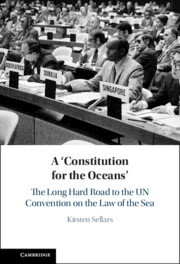Book contents
- A ‘Constitution for the Oceans’
- A ‘Constitution for the Oceans’
- Copyright page
- Contents
- Foreword
- Abbreviations
- 1 End of the Old Order
- 2 Old Freedoms, New Rights
- 3 North, South, East and West
- 4 A Conference Collapses
- 5 Internationalising the Seabed
- 6 Passage through Straits
- 7 The Archipelagic Concept
- 8 New International Orders
- 9 The Bitter End
- Afterword
- Bibliography
- Index
9 - The Bitter End
The Seabed Mining Controversy and the Signing of the Convention
Published online by Cambridge University Press: 06 February 2025
- A ‘Constitution for the Oceans’
- A ‘Constitution for the Oceans’
- Copyright page
- Contents
- Foreword
- Abbreviations
- 1 End of the Old Order
- 2 Old Freedoms, New Rights
- 3 North, South, East and West
- 4 A Conference Collapses
- 5 Internationalising the Seabed
- 6 Passage through Straits
- 7 The Archipelagic Concept
- 8 New International Orders
- 9 The Bitter End
- Afterword
- Bibliography
- Index
Summary
When the conference delegates turned their attention to seabed mining, many proclaimed the great importance of the issue – from either a positive or negative perspective – declaring that it would underwrite a new international economic order, or present a fundamental threat to land-based mining industries, or exemplify the virtues of the free market. The problem was that no state knew how profitable seabed exploitation might be, or the technological challenges involved, or its potential effect on commodities markets. Because of this uncertainty, none of them wanted to put themselves at a potential disadvantage or forego future rewards, so the negotiations were particularly hard fought and protracted. One casualty would be the common heritage concept, replaced with the parallel system by the G5 powers, and with technology transfer by the G77 countries. Another casualty was the cooperation between the industrial powers, with some proposing anti-monopoly clauses and production quotas to protect their own mining concerns and constrain competitors. The outcome managed to displease every state, but most eventually signed the convention with the agreed seabed provisions in 1982.
Keywords
- Type
- Chapter
- Information
- A ‘Constitution for the Oceans' , pp. 293 - 322Publisher: Cambridge University PressPrint publication year: 2025

